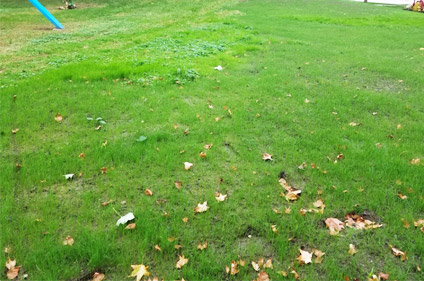There are some important factors involved in summer seeding processes that get thrown out the window this time of the year. Ordinarily, you might try to delay the project, but when that's no possible, here are some tips to improve seed success.
- These are consistent with seeding any time of the year:
- Chose the correct seed for your area.
- Select quality seed with little or no weed seed.
- Seed at the correct rate - more is not better.
- Make sure the product is current for the most pure live seed.
- Opt for mixes or blends which have 2 or more varieties and/or species.
- Consider pruning or removing trees for better airflow and sunlight penetration.
- Remove debris for better seed to soil contact.
- Seed as early in the spring as possible – this will reduce the pressure from crabgrass and other summer annual weeds.
- Consider dormant seeding. This technique is defined as seeding before the frost is gone. Heaving of the soil will help seed fall into cracks where it will germinate as soon as conditions are favorable.
- Maximize seed to soil contact.
- Prepare to irrigate as the soil temperature reaches 55 degrees F.
- Delay pre-emergence practices and plan to manage weeds later in the spring.
- Some weeds will be present especially if a cover material is used – have a plan for control.
A starter fertilizer can be applied as seedlings emerge to promote rooting and accelerate establishment. Remember that starter fertilizers are those that have a higher middle number. Plan to initiate and maintain irrigation as needed through the establishment process.
Gradually decrease the frequency of irrigation cycles as the seedlings become established and focus on deep, infrequent watering through the summer until adequate rooting is achieved. As mentioned, this is not the preferred time to seed, but by following these guidelines, the results will be good. Weeds may be present, but typically there are selective herbicides to manage them. The key is communication with the client, so the weeds are not a surprise. If there are any remaining perennial or troublesome grassy weeds, those can be addressed with spot or dab applications of non-selectives.
If seeding is scheduled for later in the spring, there are herbicides that can be applied to control weeds while still allowing for grass establishment. Tenacity can be applied at or shortly after seeding to control many weeds that will compete with new seed. Exercise caution with certain grasses including bentgrass, zoysiagrass, or fine fescue as these species are sensitive to the product. Quinclorac (Drive and others - just make sure that it isn’t in combination with another product) can be used before or at seeding with many turfgrasses and will give you 30 to 45 days of pre-emergence control of crabgrass.
AS ALWAYS, read the label.
Please reach out to the Ewing Technical Services Team if there are any questions.




